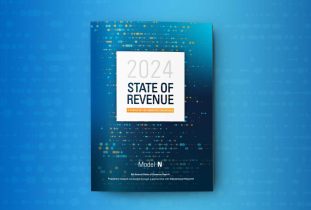Every year, Model N, in partnership with Dimensional Research, surveys c-level executives who are directly responsible for revenue management at pharmaceutical and medtech companies. The resulting 2022 State of Revenue Report uncovered that the life sciences industry continues to struggle with data visibility and management, while facing new uncertainties caused by new market and business trends and the immediate aftereffects of the pandemic.
During the 2022 State of Revenue for Life Sciences webinar, Model N’s Melonie Warfel, vice president and head of Model N EMEA; Jesse Mendelsohn, vice president; and Kyle Forcier, senior director of product marketing discussed some of the key findings from the report and associated industry implications.
The impact of new business models
A third of the executives surveyed indicated that business model changes – including value-based contracting and subscription-based pricing – are having a big impact on how they manage revenue. In the pharmaceutical industry, many of the new drugs coming to market are injectables, infusibles, or other physician-administered drugs. This has created a shift in payment from pharmacy benefits to medical benefits, which impacts how manufacturers do business.
Medtech companies are looking for creative financing models to sell more products and counteract the downward pressure being placed on customers’ capital budgets. Before rolling out deals, companies need to make sure they have the right processes and systems in place to ensure that they’re properly collecting this revenue and that its financially beneficial to the business.
Data concerns abound
Life sciences executives struggle with real-time data visibility – and this can be a significant issue for companies doing business around the globe. Given the different strategies, rules, and regulations that countries follow regarding healthcare, companies are left wondering whether they’re offering the right prices, if they’re overpaying rebates, and how competitors are faring. The long-term impact of a lack visibility could mean price erosion, slow revenue growth, or compliance concerns.
Staffing an ongoing concern
Almost all (98%) of executives report that they are currently dealing with staffing and expertise issues, and in the complicated industry of life sciences, these resourcing issues are compounded by the need for specialized staff. To combat these challenges, many organizations are looking for outsourcing options, as this enables their internal staff to work on more value-added activities. But business services aren’t the only solution; another approach that’s gaining popularity is a renewed emphasis on employee training programs. In-app training and other forms of ongoing education are proving to be extremely valuable with the rise in remote and hybrid work and the unfortunate turnover that’s occurring.
Along with the three themes outlined here, the State of Revenue for Life Sciences webinar dives deeper into how artificial intelligence can help generate better insights, what executives can do to reduce their reliance on spreadsheets, and where technology can support process improvements. Watch the State of Revenue for Life Sciences webinar on demand to get the full story. And don’t forget to download your copy of the 2022 State of Revenue Report.
















